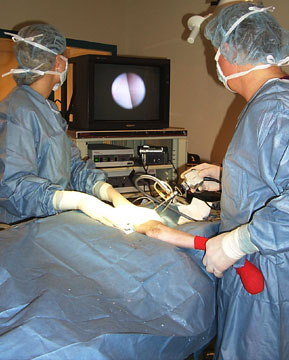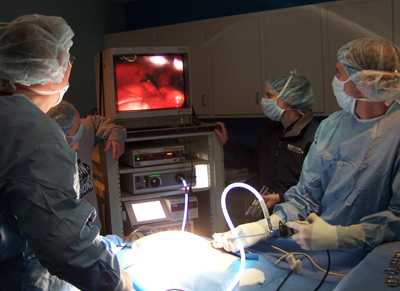Minimally Invasive Surgery
We are constantly pushing our skills to provide better surgical outcomes with less pain, less surgical trauma, less anesthetic time, and quicker return to function. Minimally invasive orthopedics allows us to achieve many of these goals with advanced imaging technology and related procedures.

Arthroscopic surgery at ProFormance Canine.
Arthroscopic Surgery
Arthroscopic surgery has been performed in equine and human surgery for nearly 30 years. It has only been in the last few years that instrumentation has become available to allow small animal surgeons to enter joints arthroscopically. We have been performing arthroscopy on the elbow and shoulder joints at Vetcision for several years. Our equipment consists of a combination of the best Stryker, Linvatec, and Storz arthroscopy systems which include a 3 chip video camera and a complement of arthroscopes, power, and hand instruments. We also have a Sony image storage and retrieval system to document our images.
In small animal arthroscopy we have become proficient at exploring and treating intra-articular conditions of the elbow and shoulder joint. We have not concentrated on cruciate repairs in the stifle joint since we feel the best current treatment is the Tibial Plateau Leveling Osteotomy (TPLO) technique. OCD lesions of the stifle, while rare, can be easily treated with arthroscopy.
Laparoscopic Surgery
Laparoscopic surgery is being performed at Vetcision predominately for liver biopsies and prophylactic gastropexies. Laparoscopic surgeries allow abdominal surgery to be performed on patients with typically only 3 small nicks in the skin. A ridged laparoscopic telescope, attached to a camera, is inserted through a cannula through a nick in the skin while instruments are inserted through cannulas at other sites through the abdomen. The surgeon uses these cannulas (portals) to insert long handled instruments working inside the abdominal cavity which is inflated with CO2 gas.
Thoracoscopic Surgery
Thoracoscopic surgery is being performed at Vetcision for lung biopsies, some lung lobectomies, and pericardectomies. Thoracoscopic surgery allows the surgeon to work in the chest cavity. Typically 3 cannulas (portals) are placed in the chest to allow a surgeon to work inside the chest with long instruments. The huge benefit of thoracoscopic surgery is the minimal postoperative pain, and early return to full function after the procedure. This is in comparison to an open chest approach that leaves the patient uncomfortable for several weeks.

Thoracoscopically performed pericardial window.